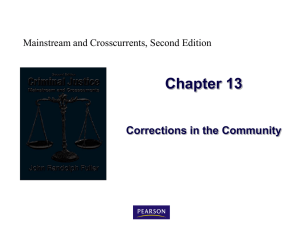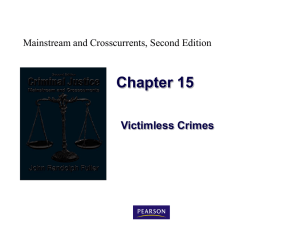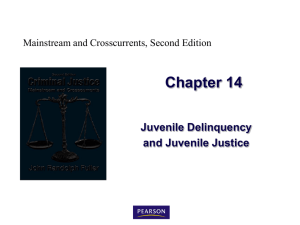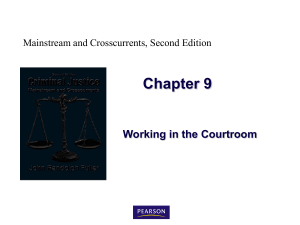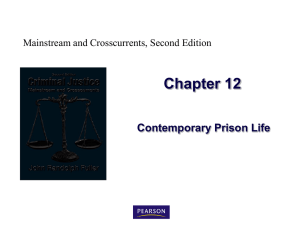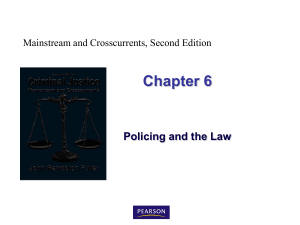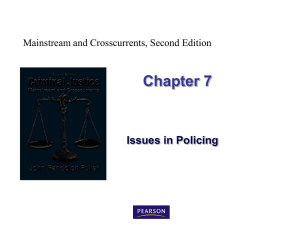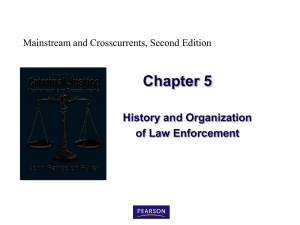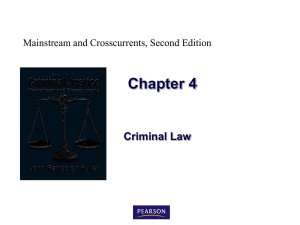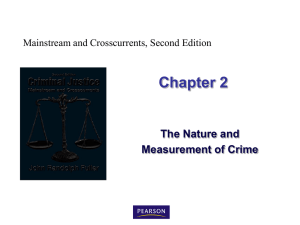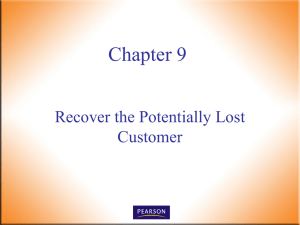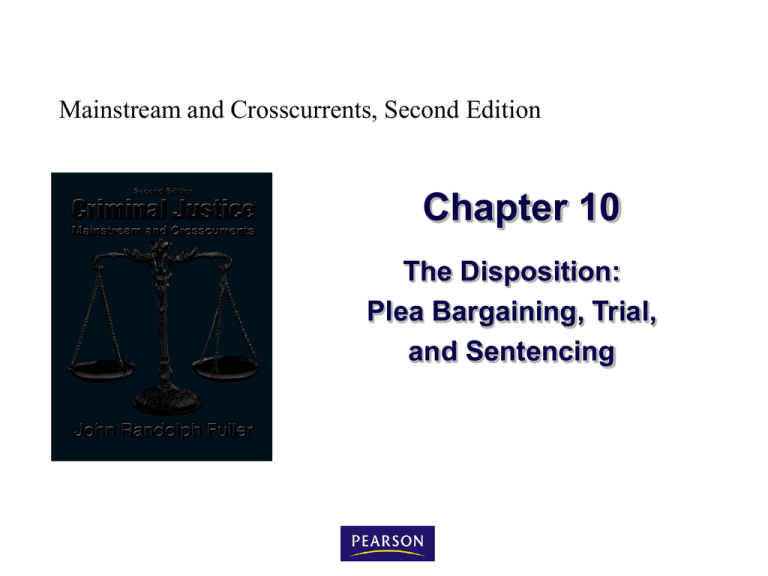
Mainstream and Crosscurrents, Second Edition
Chapter 10
The Disposition:
Plea Bargaining, Trial,
and Sentencing
Plea Bargaining
Not concerned with determining guilt
or innocence.
Allows the defendant and the
prosecution to efficiently determine
the amount of punishment without
the expense of a jury trial.
Criminal Justice: Mainstream and Crosscurrents, 2/e
John Randolph Fuller
2
© 2010 Pearson Higher Education,
Upper Saddle River, NJ 07458. • All Rights Reserved.
Plea bargaining
Vertical plea
Horizontal plea
Reduced-sentence plea
Avoidance-of-stigma plea
Criminal Justice: Mainstream and Crosscurrents, 2/e
John Randolph Fuller
3
© 2010 Pearson Higher Education,
Upper Saddle River, NJ 07458. • All Rights Reserved.
Plea bargaining
Vertical plea
By pleading guilty or nolo contendere
to a lesser included charge, the
defendant can reduce the potential
for a harsh sentence.
Criminal Justice: Mainstream and Crosscurrents, 2/e
John Randolph Fuller
4
© 2010 Pearson Higher Education,
Upper Saddle River, NJ 07458. • All Rights Reserved.
Plea bargaining
Horizontal plea
The defendant will plead guilty to a
charge in exchange for other charges
being dropped.
Criminal Justice: Mainstream and Crosscurrents, 2/e
John Randolph Fuller
5
© 2010 Pearson Higher Education,
Upper Saddle River, NJ 07458. • All Rights Reserved.
Plea bargaining
Reduced-sentence plea
The prosecutor, defense attorney,
and judge might decide on a reduced
sentence.
Criminal Justice: Mainstream and Crosscurrents, 2/e
John Randolph Fuller
6
© 2010 Pearson Higher Education,
Upper Saddle River, NJ 07458. • All Rights Reserved.
Plea bargaining
Fundamental issues
Presumption of factual guilt
Costs and risks of trial
What to do with the guilty
Criminal Justice: Mainstream and Crosscurrents, 2/e
John Randolph Fuller
7
© 2010 Pearson Higher Education,
Upper Saddle River, NJ 07458. • All Rights Reserved.
The Trial
Indictment
Defendant's plea
Prosecution opening statement
Defense opening statement
Witnesses and evidence presented
Defense closing arguments
Criminal Justice: Mainstream and Crosscurrents, 2/e
John Randolph Fuller
8
© 2010 Pearson Higher Education,
Upper Saddle River, NJ 07458. • All Rights Reserved.
The Trial
Prosecution closing arguments
Judge's instructions to jurors about procedures
Judge's instructions to jurors about verdicts
Final verdict
Defendant released if acquitted or sentenced if
convicted
Criminal Justice: Mainstream and Crosscurrents, 2/e
John Randolph Fuller
9
© 2010 Pearson Higher Education,
Upper Saddle River, NJ 07458. • All Rights Reserved.
The Trial
Pretrial motions
Opening arguments
Presentation of witnesses & evidence
The case goes to the jury
Evidence
The defense doesn't rest
Criminal Justice: Mainstream and Crosscurrents, 2/e
John Randolph Fuller
10
© 2010 Pearson Higher Education,
Upper Saddle River, NJ 07458. • All Rights Reserved.
CrossCurrents The trial
Evidence that can’t be used
When a defendant is set free because of a legal
technicality, the exclusionary rule might be the
reason.
The exclusionary rule covers three types of
evidence: the identification of suspects,
confessions in which the Miranda rules apply,
and some searches.
Criminal Justice: Mainstream and Crosscurrents, 2/e
John Randolph Fuller
11
© 2010 Pearson Higher Education,
Upper Saddle River, NJ 07458. • All Rights Reserved.
The Trial
Pretrial motions
Motion for dismissal of charges
Motion for continuance
Motion for discovery
Motion for severance of defendants
Motion for severance of offenses
Criminal Justice: Mainstream and Crosscurrents, 2/e
John Randolph Fuller
12
© 2010 Pearson Higher Education,
Upper Saddle River, NJ 07458. • All Rights Reserved.
The Trial
Pretrial motions
Motion for the suppression of evidence
Motion to determine competency
Motion for change of venue
Criminal Justice: Mainstream and Crosscurrents, 2/e
John Randolph Fuller
13
© 2010 Pearson Higher Education,
Upper Saddle River, NJ 07458. • All Rights Reserved.
The Trial
Opening arguments
The prosecution makes the first opening
argument.
No evidence is presented.
The defense counters the prosecution's
outline of the case.
Criminal Justice: Mainstream and Crosscurrents, 2/e
John Randolph Fuller
14
© 2010 Pearson Higher Education,
Upper Saddle River, NJ 07458. • All Rights Reserved.
The Trial
Presentation of witnesses & evidence
The prosecution begins the presentation
of the case by introducing evidence and
witnesses.
Defense may cross-examine.
Prosecution may redirect examination.
Criminal Justice: Mainstream and Crosscurrents, 2/e
John Randolph Fuller
15
© 2010 Pearson Higher Education,
Upper Saddle River, NJ 07458. • All Rights Reserved.
The Trial
Presentation of witnesses & evidence
Defense may request re-crossexamination and/or directed verdict of
acquittal.
Defense presents evidence & witnesses
Summation
Criminal Justice: Mainstream and Crosscurrents, 2/e
John Randolph Fuller
16
© 2010 Pearson Higher Education,
Upper Saddle River, NJ 07458. • All Rights Reserved.
The Trial
Case goes to the jury
Serving on a jury allows citizens to
participate in the criminal justice system
as a check-and-balance against
government power.
Criminal Justice: Mainstream and Crosscurrents, 2/e
John Randolph Fuller
17
© 2010 Pearson Higher Education,
Upper Saddle River, NJ 07458. • All Rights Reserved.
The Trial
Case goes to the jury
Steps of jury selection …
Master jury list
Venire
Voir dire
Criminal Justice: Mainstream and Crosscurrents, 2/e
John Randolph Fuller
18
© 2010 Pearson Higher Education,
Upper Saddle River, NJ 07458. • All Rights Reserved.
Case goes to the jury
Voir dire
The defense attorney or prosecutor
can attempt to exclude a juror by …
Challenge for cause
Peremptory challenge
Criminal Justice: Mainstream and Crosscurrents, 2/e
John Randolph Fuller
19
© 2010 Pearson Higher Education,
Upper Saddle River, NJ 07458. • All Rights Reserved.
The Trial
Evidence
The prosecutor must base a case on
evidence.
The prosecutor must prove beyond a
reasonable doubt that the
defendant is guilty.
Criminal Justice: Mainstream and Crosscurrents, 2/e
John Randolph Fuller
20
© 2010 Pearson Higher Education,
Upper Saddle River, NJ 07458. • All Rights Reserved.
The Trial
Evidence
Classifications of evidence
Real evidence
Testimony
Direct evidence
Indirect evidence
Criminal Justice: Mainstream and Crosscurrents, 2/e
John Randolph Fuller
21
© 2010 Pearson Higher Education,
Upper Saddle River, NJ 07458. • All Rights Reserved.
The Trial
The defense doesn't rest
Reasonable doubt
Defendant testimony
Alibis
Affirmative defense
Challenging scientific evidence
Criminal Justice: Mainstream and Crosscurrents, 2/e
John Randolph Fuller
22
© 2010 Pearson Higher Education,
Upper Saddle River, NJ 07458. • All Rights Reserved.
Rights & wrongs in the courthouse
The rights enjoyed by defendants in
criminal trials are derived from the
Constitution, specifically the Bill of
Rights.
Criminal Justice: Mainstream and Crosscurrents, 2/e
John Randolph Fuller
23
© 2010 Pearson Higher Education,
Upper Saddle River, NJ 07458. • All Rights Reserved.
Rights & wrongs in the courthouse
I know my rights
Victims' rights
Criminal Justice: Mainstream and Crosscurrents, 2/e
John Randolph Fuller
24
© 2010 Pearson Higher Education,
Upper Saddle River, NJ 07458. • All Rights Reserved.
Rights & wrongs in the courthouse
I know my rights
Right to a speedy trial
Right to confront witnesses
Right against self-incrimination
Right against excessive bail
Right to an impartial jury
Criminal Justice: Mainstream and Crosscurrents, 2/e
John Randolph Fuller
25
© 2010 Pearson Higher Education,
Upper Saddle River, NJ 07458. • All Rights Reserved.
Rights & wrongs in the courthouse
Victims' rights
When a prosecutor charges a suspect
with an offense, it is considered an
offense against the state even
though there is most likely a human
victim as well.
Criminal Justice: Mainstream and Crosscurrents, 2/e
John Randolph Fuller
26
© 2010 Pearson Higher Education,
Upper Saddle River, NJ 07458. • All Rights Reserved.
Sentencing
Indeterminate sentencing
Determinate sentencing
Mandatory minimum sentences
Criminal Justice: Mainstream and Crosscurrents, 2/e
John Randolph Fuller
27
© 2010 Pearson Higher Education,
Upper Saddle River, NJ 07458. • All Rights Reserved.
Sentencing the offender
Indeterminate sentencing
The parole board has the discretion to
determine when the offender is ready for
release.
Based on the medical model of
corrections
Popular during the 1950s and 1960s
Criminal Justice: Mainstream and Crosscurrents, 2/e
John Randolph Fuller
28
© 2010 Pearson Higher Education,
Upper Saddle River, NJ 07458. • All Rights Reserved.
Sentencing the offender
Indeterminate sentencing
Three assumptions …
The offender is sick and prison staff
can diagnose the problem.
The prison can treat the problem.
The staff and parole board can
determine if the inmate has been
successfully treated.
Criminal Justice: Mainstream and Crosscurrents, 2/e
John Randolph Fuller
29
© 2010 Pearson Higher Education,
Upper Saddle River, NJ 07458. • All Rights Reserved.
Sentencing the offender
Determinate sentencing
Laws restrict the discretion of criminal
justice decision-makers.
The perceived advantage is uniformity.
Presumptive sentencing allows
judges some departure from the
guidelines.
Criminal Justice: Mainstream and Crosscurrents, 2/e
John Randolph Fuller
30
© 2010 Pearson Higher Education,
Upper Saddle River, NJ 07458. • All Rights Reserved.
Sentencing the offender
Determinate sentencing
Criminal Justice: Mainstream and Crosscurrents, 2/e
John Randolph Fuller
31
© 2010 Pearson Higher Education,
Upper Saddle River, NJ 07458. • All Rights Reserved.
CrossCurrents Sentencing the offender
Special interest laws
Groups and individuals can affect
lawmaking.
Examples include: drunk-driving laws,
hate-crime laws, and sex-offender laws.
Criminal Justice: Mainstream and Crosscurrents, 2/e
John Randolph Fuller
32
© 2010 Pearson Higher Education,
Upper Saddle River, NJ 07458. • All Rights Reserved.
Sentencing the offender
Mandatory minimum sentences
Weapons violations
Repeated drunk driving
Drug sales and drug kingpin laws
Three-strikes laws
Truth in sentencing
Criminal Justice: Mainstream and Crosscurrents, 2/e
John Randolph Fuller
33
© 2010 Pearson Higher Education,
Upper Saddle River, NJ 07458. • All Rights Reserved.
Questions
What are the four types of pleas?
Explain the major pretrial motions.
What are voir dire and venire?
Criminal Justice: Mainstream and Crosscurrents, 2/e
John Randolph Fuller
34
© 2010 Pearson Higher Education,
Upper Saddle River, NJ 07458. • All Rights Reserved.

